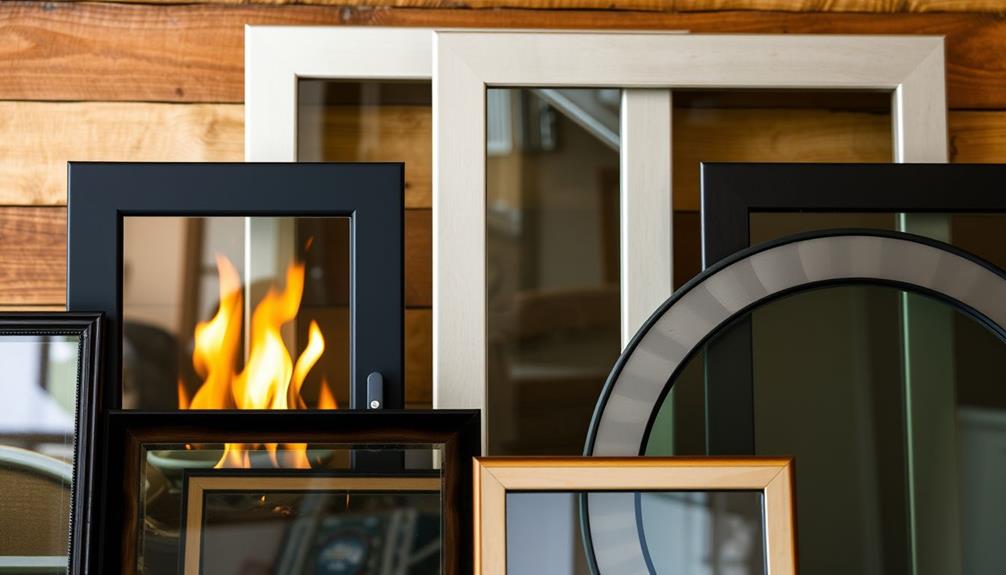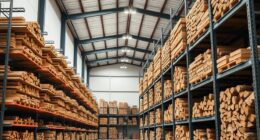When you're comparing wood stove door glass, consider options like tempered, mica, ceramic, and pyroceram. Tempered glass is strong but can't handle high heat, making it unsuitable for wood stoves. Mica glass resists extreme temperatures but offers less clarity. Ceramic glass is popular and provides a clear view while enduring up to 1200°F, perfect for modern stoves. Pyroceram is great for rapid temperature changes and maintains clarity. Each type has its pros and cons, so it's crucial to evaluate them based on your stove's needs. There's plenty more to uncover about each type and their best applications.
Key Takeaways
- Ceramic glass is ideal for modern wood stoves, enduring up to 1200°F while providing clear visibility of flames with slight amber tint.
- Mica glass withstands extreme heat (up to 1800°F) and enhances vintage aesthetics, but offers a semi-transparent view of flames.
- Tempered glass is shatter-resistant and provides good visibility but is unsuitable for wood stoves due to heat limitations (max 500°F).
- Pyroceram/Neoceram glass excels in rapid temperature changes and high durability, designed specifically for extreme heat applications.
- Robax glass combines thermal insulation with high clarity, making it a favored choice in modern wood stove designs.
Types of Wood Stove Glass
When it comes to wood stove glass, there are five main types to contemplate, each with its own unique properties.
First up is tempered glass, which is about four times stronger than standard window glass. It offers a good view of the flames, but you should avoid using it in wood stoves since it can only handle temperatures up to 400-500 degrees Fahrenheit. Additionally, it's important to ensure proper ventilation when using any type of gas or wood appliance for safety.
Next, you've got mica glass, which is incredibly thin and can withstand temperatures up to 1800 degrees Fahrenheit. It's often found in older pot-belly stoves and can be easily customized.
Then there's ceramic glass, popular in modern wood stoves, providing a clear view with a slight amber tint, though it doesn't have the strength of tempered glass.
For high temperatures, consider pyroceram and neoceram, designed to endure extreme heat (up to 1200 degrees Fahrenheit) and rapid temperature changes, making them perfect for your wood stove.
Finally, robax glass is a transparent ceramic that offers excellent thermal insulation and clarity, making it a favorite in many modern setups.
Each type has its strengths, so weigh your options carefully!
Characteristics of Tempered Glass
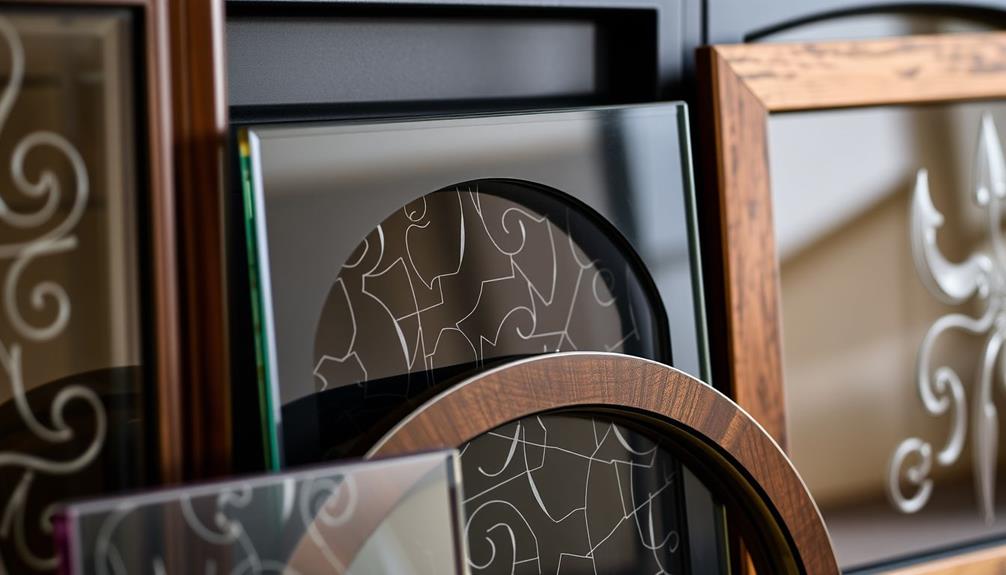
When you think about tempered glass, you're looking at a material that's four times stronger than standard glass, making it incredibly durable. This durability is fundamental in various applications, but when it comes to wood stoves, the type of glass used must withstand higher temperatures and resist thermal shock.
However, its heat resistance has limits, typically ranging from 400 to 500 degrees Fahrenheit, which means it's not safe for wood stoves. Plus, if it does break, it shatters into small pieces, reducing the risk of injury, but that doesn't compensate for its unsuitability in high-heat environments.
For wood stoves, materials designed for efficient heat distribution are vital to maintaining peak performance.
Strength and Durability
Strength and durability are essential factors to take into account when evaluating wood stove door glass, especially when it comes to tempered glass. This type of glass is engineered to be four times stronger than standard window glass, giving you enhanced protection for your stove. It can withstand temperatures ranging from 400 to 500 degrees Fahrenheit without compromising its structural integrity.
Additionally, using materials that can endure high temperatures is vital, similar to geothermal energy utilization which focuses on harnessing the earth's heat effectively.
Here are a few key points about tempered glass:
- It shatters into thousands of small, blunt pieces, reducing the risk of injury compared to traditional glass.
- The production process takes 10-14 days, ensuring that the glass achieves its impressive strength characteristics.
- Despite its high strength, tempered glass isn't the best choice for wood stoves due to its lower heat resistance compared to specialized glass types.
While tempered glass offers significant benefits regarding strength and safety, it's important to take into account its limitations.
When selecting glass for your wood stove door, understanding these characteristics will help you make an informed decision that balances durability and heat resistance.
Heat Resistance Limits
Evaluating the heat resistance limits of tempered glass reveals significant drawbacks for wood stove applications.
While it's designed to withstand temperatures up to 400-500 degrees Fahrenheit, this range simply isn't sufficient for the extreme heat generated by wood stoves. In fact, using materials like butter in cooking can also be sensitive to temperature, emphasizing the importance of choosing appropriate materials for high-heat environments butter's melting point.
Even though tempered glass is four times stronger than standard window glass and undergoes heat treatment to enhance its strength, it can't handle the prolonged exposure to flames that wood stoves create.
When tempered glass does break, it shatters into tiny pieces, which might seem safer than standard glass. However, this characteristic doesn't compensate for its inability to endure the high temperatures typical in these environments.
For wood stoves, you'll find that safety glass options like ceramic glass or mica glass are far better choices. Ceramic glass offers superior heat resistance, making it more suitable for the demands of wood stove use.
Safety Features Overview
Tempered glass boasts impressive safety features that set it apart from standard glass options. When considering glass doors for your wood stove, understanding these characteristics can be essential for safety.
Here are three key features of tempered glass:
- Strength: It's four times stronger than regular window glass, making it highly resistant to impact and breakage. Many dog owners prioritize safety products, just like they do with dog health and nutrition considerations.
- Heat Resistance: Designed to withstand temperatures between 400 to 500 degrees Fahrenheit, it's reliable for many high-heat applications.
- Safety on Breakage: If it does break, tempered glass shatters into thousands of small, blunt pieces instead of sharp shards, markedly reducing the risk of injury.
While these attributes make tempered glass appealing, be cautious.
It's not suitable for wood stove applications due to the extreme heat generated. Using tempered glass doors in a stove could lead to potential hazards.
Always opt for glass specifically designed for wood stoves, ensuring you maintain safety without compromising on functionality.
Features of Mica Glass
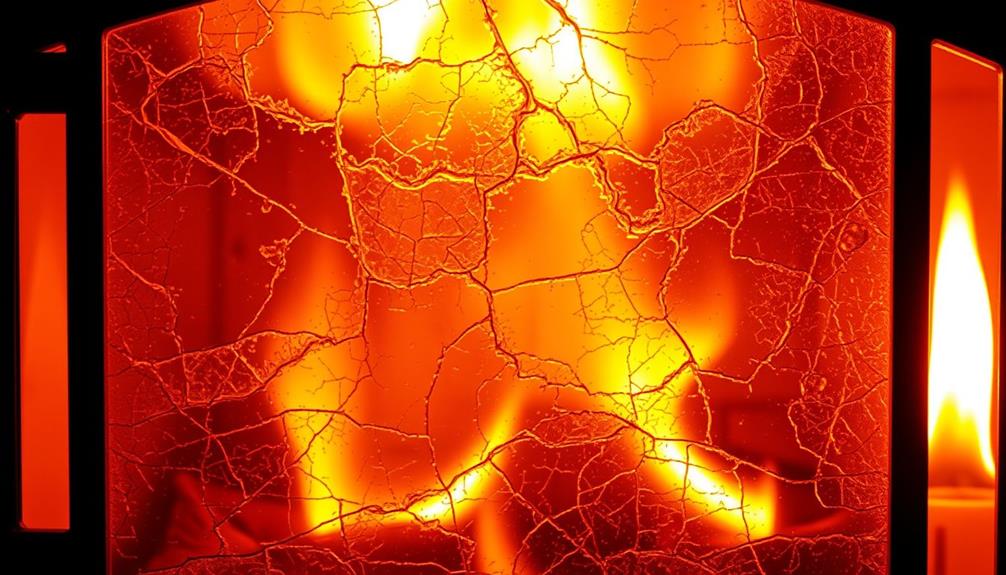
Mica glass boasts several distinct features that make it a popular choice for wood stove doors. First and foremost, it's a natural mineral, incredibly thin—about the thickness of paper—and can be easily cut with a razor blade. This flexibility allows for customized installations tailored to your wood stove.
Additionally, its warm, inviting glow can enhance the atmosphere of your space, similar to how a modern farmhouse bedroom creates a serene environment.
One of the standout characteristics of mica glass is its impressive temperature tolerance, capable of withstanding temperatures up to 1800 degrees Fahrenheit. This makes it highly suitable for the intense conditions of wood stoves.
Additionally, mica glass lets some light through, giving you a semi-transparent view of the flames while adding a vintage aesthetic to your setup.
However, it's important to take into account that the clarity of mica glass is generally lower than other types of stove glass, which can affect your visibility of the fire.
Also, due to the material properties of mica glass, it tends to be more expensive, especially as the size of the pieces increases.
Despite these factors, many choose mica glass for its unique blend of beauty and functionality, making it a worthy option for your wood stove door.
Properties of Ceramic Glass
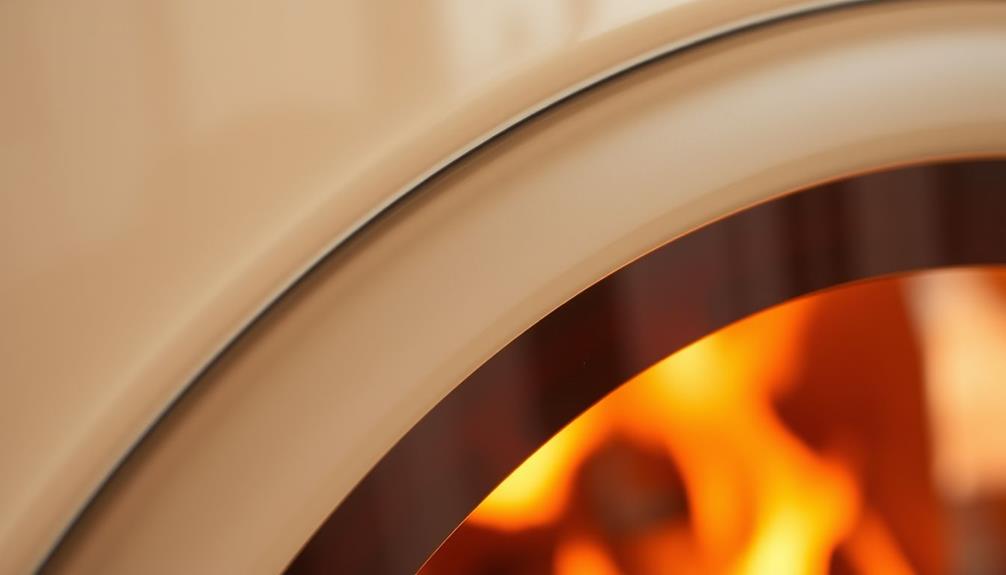
Ceramic glass is an excellent choice for wood stove doors, thanks to its ability to withstand high temperatures of up to 1,200°F (648°C). This makes it ideal for closed-door wood stoves, ensuring safety and efficiency while you enjoy your fire.
Additionally, ceramic glass can enhance your home's security by providing a robust barrier against heat and flames, similar to how AI security provides robust defenses against cyber threats.
One of the standout features of ceramic glass is its clarity. You'll appreciate how it provides a clear view of the flames, complete with an appealing amber tint that enhances your stove's aesthetic.
Additionally, ceramic glass excels in heat retention, making it more efficient for indoor heating compared to tempered glass.
Here are a few more properties that make ceramic glass a prime pick:
- Custom cutting options to fit various stove designs and sizes.
- Superior durability, ensuring a long-lasting investment for your heating needs.
- Excellent thermal performance, which helps maintain ideal heat levels.
While ceramic glass may be pricier than tempered glass, its benefits in thermal efficiency and durability make it worth considering.
Considerations for Glass Selection
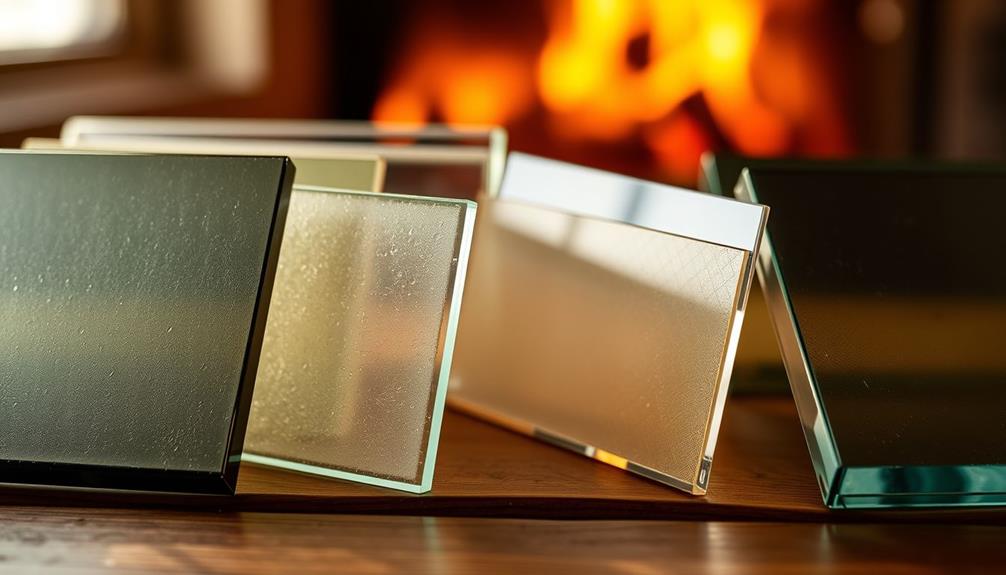
When you're choosing glass for your wood stove door, safety and compliance with regulations are key factors to take into account.
It's important to guarantee that the glass can withstand the intense heat generated during operation, as improper materials can lead to dangerous situations.
Additionally, clogging remedies can apply to maintaining a safe environment around your stove.
You'll also want to think about heat resistance requirements to guarantee the glass can handle the temperatures generated.
Plus, the aesthetic and design impact of the glass can enhance the overall look of your stove, so keep that in mind as well.
Safety and Compliance
Selecting the right glass for your wood stove door is critical for guaranteeing safety and compliance with local regulations. The type of glass you choose can greatly impact both the performance of your stove and the safety of your home.
Additionally, understanding the process of conversion for retirement accounts can provide insights into how to manage assets effectively, much like selecting the right materials for your stove. Here are some key considerations:
- Temperature Resistance: Ceramic glass can withstand temperatures up to 1,200°F, while tempered glass only endures up to 500°F. Choosing the right type is essential for minimizing breakage risks.
- Regulatory Compliance: Make sure the glass meets local safety standards for wood stove installations. Non-compliance can lead to legal issues or unsafe conditions.
- Compatibility with Stove Model: Guarantee the selected glass is suitable for your specific stove's operating conditions to avoid inefficiencies and potential hazards.
Regular inspections and maintenance of the glass are necessary to uphold safety compliance.
Look for signs of warping or degradation, as these may indicate the need for replacement.
Heat Resistance Requirements
Understanding heat resistance requirements is essential for choosing the right glass for your wood stove door. Different types of glass can withstand varying temperatures, which directly impacts their suitability for your stove.
For high-heat applications, ceramic glass is a top choice, enduring up to 1,200°F (648°C). Additionally, ginger's health benefits may parallel the importance of selecting durable materials for peak performance.
However, if you're considering tempered glass, be aware that it's limited to 500°F (260°C) and generally isn't recommended for wood stoves due to this restriction.
If you have an older pot-belly stove, mica glass might be an option, as it tolerates temperatures up to 1,800°F (982°C), although it's less transparent than other types.
Pyroceram glass is another solid choice, known for its high temperature resistance and durability against thermal stress.
Finally, neoceram glass stands out for its ability to handle rapid temperature changes while maintaining safety and performance without significant distortion.
When selecting glass for your wood stove door, always prioritize heat resistance to maintain peak function and safety. Choosing the correct glass type will enhance your stove's performance and longevity.
Aesthetic and Design Impact
The choice of glass for your wood stove door does more than just serve a practical purpose; it shapes the aesthetic and design of your living space.
The type of glass you select can greatly influence the overall ambiance and visual experience. For instance, ceramic glass not only provides a clear view of the flames but also adds a warm, amber tint that enhances the cozy feel of your room.
Consider these factors when choosing your glass:
- Clarity: Tempered glass offers unobstructed visibility of the fire but may lack the heat resistance of ceramic, potentially affecting its long-term look.
- Vintage Appeal: Mica glass brings a retro vibe but might limit how clearly you see the flames, impacting design.
- Customization: Ceramic glass allows for unique patterns and sizes, letting you tailor the look to match your interior style.
Pros and Cons of Glass Types

When choosing the right glass type for your wood stove, it's crucial to weigh the pros and cons of each option.
Ceramic glass is a popular choice due to its ability to withstand high temperatures up to 1200°F, making it ideal for modern wood stoves. You'll enjoy a clear view of the flames, which adds to the ambiance of your space. However, it can be more expensive than other options.
Tempered glass, while shatter-resistant and providing good visibility, isn't suitable for wood stoves because it can only handle temperatures up to 500°F, which is often exceeded.
Mica glass, on the other hand, is perfect for vintage stoves and can endure up to 1800°F, but it sacrifices clarity.
Pyroceram and Neoceram offer excellent thermal resistance, with Neoceram boasting superior thermal shock resistance. However, design options may be limited.
Finally, Robax glass provides great thermal insulation and clarity but can crack under extreme heat if not installed correctly.
Balancing these pros and cons will help you find the best fit for your specific needs.
Maintenance and Replacement Tips

Maintaining your wood stove door glass is essential for both safety and performance. Regular upkeep guarantees you can enjoy the beauty of the flames while keeping your home safe from potential hazards. Here are some key maintenance tips to follow:
- Clean the glass door regularly with a soft, non-abrasive cloth and a specialized glass cleaner to prevent soot and creosote build-up.
- Inspect the glass for cracks or warping periodically, as damaged glass can pose safety risks and may require immediate replacement.
- When replacing the glass, choose the correct type based on your stove model, using options like ceramic or mica for high-heat applications.
Always use the manufacturer's specifications for thickness and size when ordering replacement glass to assure a proper fit. This will help maintain the efficiency of your wood stove.
If you're uncertain about installation or replacement, always consult with a professional to guarantee safety and compliance with local regulations regarding wood stove use.
Taking these steps will keep your stove door glass in top condition, enhancing both your fireplace experience and your home's safety.
Frequently Asked Questions
What Type of Glass for a Wood Stove?
When choosing glass for your wood stove, consider ceramic glass for high heat tolerance and clarity. If you have an older stove, mica glass might work, but it's less transparent than other options.
How to Tell the Difference Between Tempered and Ceramic Glass?
You're staring at the glass, unsure if it's tempered or ceramic. Feel for warmth; ceramic's heat resistance is unmatched. Check for clarity; ceramic reveals flames beautifully, while tempered might show a slight tint. Choose wisely!
What Type of Glass for Fireplace Doors?
When choosing glass for fireplace doors, consider your needs. Ceramic glass is great for high heat, while tempered glass offers safety. For vintage styles, mica glass works well, but modern options like Robax provide clarity and durability.
Is Stove Glass Different?
Yes, stove glass is different. It's specially designed to withstand high temperatures, unlike standard glass. You'll find options like ceramic and mica, which guarantee safety and performance in your wood stove environment.
Conclusion
When choosing wood stove door glass, it's essential to weigh the pros and cons of tempered, mica, and ceramic options. Each type has unique properties that can affect your stove's performance and safety. While tempered glass offers durability, some believe mica's natural insulation is superior in certain conditions. Ultimately, your choice should align with your heating needs and maintenance preferences. Remember, investing in the right glass can enhance both the efficiency and the longevity of your stove.

